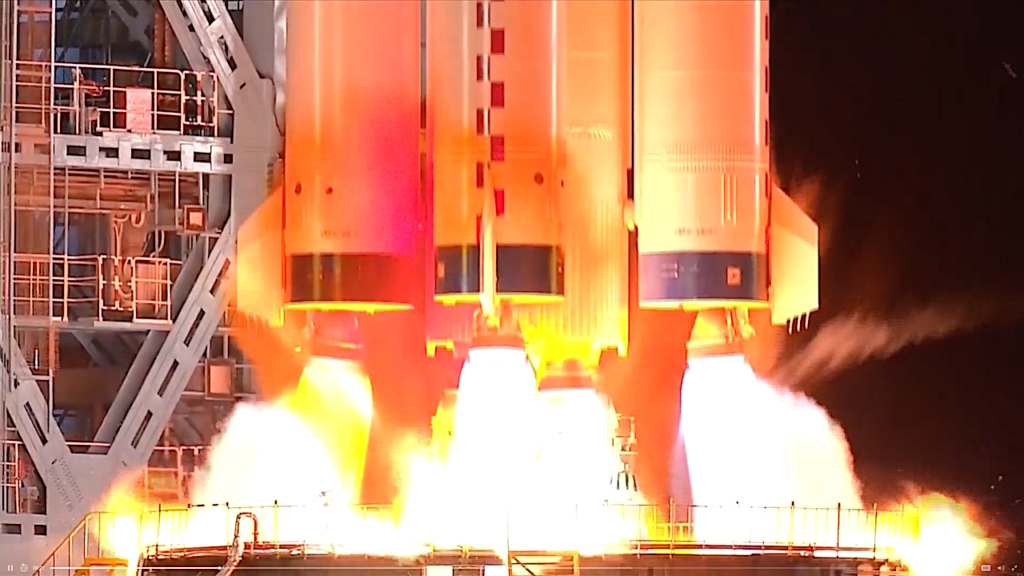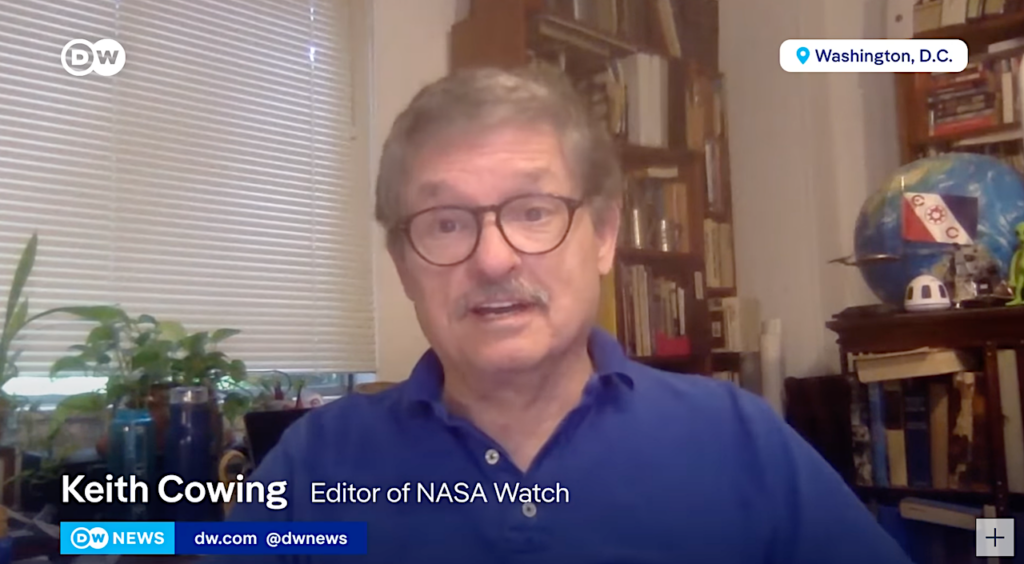China Wonders "Why Doesn't America Go Back to the Moon?"

China’s Bizarre Stereotypes of the United States, Foreign Policy
“Carp consumption and Anne Hathaway are not topics one would expect to feature prominently in the world’s most important bilateral relationship. Yet both are among the most common things that Chinese netizens ask about the United States, at least according to the autocomplete feature of Baidu, China’s most popular search engine. … “Why doesn’t America go back to the moon?” This query leads to a few links rooting the decision in the United States’ evolving national priorities following the end of the space race with the USSR. More common, though, it seems an excuse to indulge in speculation about the presence of alien artifacts on the lunar surface, something common in U.S. conspiracy theory circles as well.”
– NASA Astronaut Andy Thomas is Still Bashing China On The Job, earlier post
– Earlier China posts









Well at least the consensus there is that the US did go to the moon. An improvement over US Google results. Web filtering works!
We are only a few years away from the public accepting – as normalized ‘fact’ – that the Apollo missions were faked!! This mad, ugly meme is spreading like cancer – and the internet is also full of junk implying that the ISS and Chinese space accomplishments are faked; through a combination of CGI and water tanks?! I’m absolutely NOT kidding – I’ve been ringing the alarm bells about this garbage for a couple years now. And don’t even get me started on the rise of the flat Earth movement. Intellectual de-evolution is well underway… :'(
Yep. We are devaluing public education; colleges are ranked according to how much money a degree brings the recipient, ignoring the enhanced value of critical thinking; and students graduate with hundreds of thousands in debt. Campus infrastructure is failing all over the country (Hello, Kansas?), while governors scream ‘tax cut’ and then look for more bone to cut.
Dismal times indeed.
Why? Been there, done that. Numerous times, in fact, with both robotic and manned spacecraft.
The Moon is nearby and has significant geological interest. But Mars is the most earthlike place that isn’t Earth.
Titan. A thick atmosphere and seas/lakes are Earth-like qualities.
You might just check out the envrionmental conditions on Titan.
https://en.wikipedia.org/wi…
Mars would be tough to settle, no question about it, but still possible with current or foreseeable technology. Titan’s a whole different story.
But with the been there, done that mentality, we’ll never settle Mars or anywhere for that matter.
The been there done that mentality implies that the whole enterprise is “boots and flags”. Apollo should have been beginning of colonizing the Moon, not the last.
Sadly, that was exactly what it was for.
Since I’m writing a paper on the subject, I’ll just add that complex hydrocarbons in the atmosphere also make Titan more Earth-like. Especially if, returning to the original topic of this discussion, you live in Beijing.
Wouldn’t the temperature dominate the extant chemistry? I’d expect reactions to be somewhat different than we’d see in an energy-rich environment; some would be much slower, indeed many [most?] with insufficient energy to proceed.
If that’s the case, compounds are likely mostly primordial?
I should be careful when I say “complex” hydrocarbons. The biggest we’ve measured is a few thousand AMU (call it a few hundred carbon atoms.) Mostly, it’s more like a few dozen carbon atoms. That’s complex compared to the precursors (methane and molecular nitrogen) but not compared to things like amino acids.
Anyway, these things are seen in the upper atmosphere. The chemistry is driven by solar UV, which splits up methane and causes all sorts of reactions which build up larger molecules. This stuff also condenses out and drifts down to lower altitudes forming the haze layer. It doesn’t get to the surface as a gas, so my line about smog and Beijing wasn’t fair.
But is still is far more like the Moon than the Earth. But generations have been raised on the science fiction on Mars starting with H.G. Wells, so it has had a mystic hold on the imagination of Americans. Even in the 1950’s the Moon was only seen as a pit stop on the way to Mars.
So although we know now that the Earth like Mars is an illusion many still cling to that image of it. Indeed, even the search for life on Mars is an echo of H.G. Wells and Percival Lowell’s books of Mars being a dying world with life just struggling to survive.
And that is why America hasn’t gone back to the Moon, we still want to find the last Martians.
I agree that a fascination exists with Mars as a “Little Earth,” but I would start that fascination long before H.G. Wells. My own datum point is the discovery of its 24-hour day, clouds, and the polar caps in the 17th century by Huygens and Cassini.
Also, Mars has had flowing water, lakes, perhaps even a northern ocean, rain, snow, and glaciers. It currently has a large hydrosphere in the form of ground-ice.
These features are all alien to the Moon — and sufficiently earthlike to fire up Earthlings’ dreams for centuries.
I would challenge anyone to identify a non-Earth body in the solar system that is more earthlike than Mars.
Put simply, it’s the natural next step for humans.
We have an Earth. Been there, done that. DUH!
Let’s go someplace that’s different and learn something new.
Yes, there is another 🙂
http://www.space.com/6968-o…
Both closer and more interesting in terms of resources for a space based society. But it’s public relations have suffered since we learned we couldn’t plant a flag or place footsteps on it.
The difference between Earth and Mars is everything humans actually need to survive in space.
Mars itself contributes “somewhere to stand” and “rotates roughly once per day.” These are not difficult things to generate elsewhere.
Indeed. I’m confounded by the ‘race to the gravity well’ mindset as well.
Mars as a place for humans has about as much thoughtful foundation as SLS.
Ready with those outriggers, boys?
It minimizes the infrastructure you have to build in space. You can use Martian materials, (probably) Martian water, and the Earth-like day means you don’t have to add in a ton of artificial lighting just to grow crops in insulated greenhouses.
Basically, Mars is where you’d want to go if you were trying to establish a colony for a colony’s sake, but couldn’t afford to build a space habitat near Earth.
This was my point. A settlement on Mars is a “space habitat”. You require all the same elements and systems, there’ll be some differences in how they function, but not in necessity and cost.
Mars just means you have the added cost of getting it there, and landing it.
It’s not as if such materials aren’t common elsewhere in the solar system. Indeed, lunar polar ice may be much more accessible, even ignoring the proximity. (Ie, two settlements on the surface of Mars and moon, lunar ice may be more accessible to the lunar settlement than Martian ice is to the Martian settlers.)
Any free-flying facility can use perpetual sunlight. Even a lunar polar facility can have sites of near-perpetual sunlight. That is better than Mars.
The day/night cycle on Mars means you need much more power storage to survive the nights. The atmosphere adds thermal issues at night, which may rule out “greenhouses”, thus making you dependent on artificially lit grow-chambers buried under regolith.
That’s the trap with Mars. People are tricked into thinking it’s “Earthlike” and imagine things you would do on Earth. Like put up a greenhouse. But when you drill into the details, you end up with a closed cylinder buried under regolith and lit by artificial light. In other words, pure “space habitat”. You might as well build it inside a wet-C-type asteroid.
That seems unlikely to me. The ice at the bottom of a 4.2 kilometer deep crater in perma-darkness and extreme cold, while the good sunlight is at the top of mountain peaks around the crater edge. Whereas Martian water and energy could be available at the landing site, with the water in the permafrost.
My last paragraph was essentially saying that Mars is a second best option to a free-flying space colony near Earth. The latter would be superior, but you’d also either need to launch all the materials from Earth or harvest them from space sources to bring them to the construction site. That means either mining lunar resource and launching them into space, or churning up loosely bound asteroids and sifting them in microgravity.
Permafrost is at the high-latitudes. Out of reach of any human settlement on Mars.
There’s some suggestion of lower-latitude ice sources, but those are likely to be either deep (requiring extensive mining) or hyper-saline (requiring extensive processing.) Otherwise, it’s about trying to crack water out of hydrated minerals.
Either way, like everything else on Mars, it’s not as easy as you picture.
While lunar ice and lunar sunlight are at different sites, they are likely to be vastly closer than Martian bases and surface-accessible Martian water.
[Others have pointed out, “cryo-cold” in a vacuum is not as bad as “very cold” in a (partial) atmosphere. In a vacuum, it’s harder to eliminate heat than to create it. Hence even having humans working inside those shadowed craters is probably going to be technologically easier than having humans on the surface of Mars. There are problems to be solved, but the solutions tend to be easier than those required for Mars.]
That’s not quite right on two counts.
First, there is water in the Martian atmosphere, so you wouldn’t need to drive to high latitudes and dig up permafrost. Admittedly, there isn’t much water in the atmosphere. Not enough for industrial applications. But enough to replace losses from a (mostly) closed-loop life support system.
Second, Mars is a fairly benign thermal environment. Designing for a very hot or a very cold environment is a straight-forward engineering problem. The real difficult problem is designing one system to deal with both extremely hot and cold external conditions. You can get that on the Moon just by going from sunlight into a shadow. On Mars, it’s mostly day/night and seasonal. And, although much greater than on Earth, the magnitude of those changes is much less than on the Moon.
Again this equates cold=cold.
Cold in an atmosphere (even one as thin as Mars) is fundamentally different than cold (lack of sunlight) in a vacuum.
The entire ECLSS architecture used in space to date, in spacecraft and especially space-suits, won’t work on Mars. But Earth climate control doesn’t work either. You are starting from scratch. That’s not the case on the moon.
(Non-polar sites on the moon are more difficult, obviously. But the only reason to send anything back to the moon besides a few robotic rovers is polar resources.)
As for water in Mars’ atmosphere, any “colony” is going to need more water than just replacing ECLSS losses. A NASA science mission might cope without industrial processes, but a colony would be severely crippled without access to bulk water.
It’s been a while, but I once worked on thermal designs for a Mars EVA suit. So I’m fairly clear on what cold means.
The problem is that the current approach, which does work on the Moon, isn’t usable for any sustained presence. The approach is to more-or-less completely isolate the astronaut from the external temperature of the suit. That’s a solution which is forced by the huge range of external conditions present on the Moon or on orbit. Fortunately, that’s in a vacuum, and that enables some very effective insulation. But this approach also requires removing all the astronaut’s metabolic heat (as well as heat from the suit’s electronics) by sublimating off ice. That consumes over 0.5 kg/hour. That’s not practical, so someone’s going to have to find a different approach. I’m not sure what that would be.
Mars, on the other hand, is an environment where MLI doesn’t work. So you can’t completely isolate the astronaut from external temperatures. But that’s not necessarily bad. Since the range of external temperatures is much lower, you don’t need that thermal isolation. It opens the door for other ways of rejecting heat. I wouldn’t say this is a solved problem, but it’s been shown that solutions exist.
As far as water goes, I think you’re assuming things about the nature of a colony and its industries. I also think someone living there might feel some comfort knowing that enough water to stay alive is easily available.
My ‘outrigger’ comment draws a parallel between the South Seas’ Islanders voyages between very far-flung islands and the current state of our ability to visit Mars.
And while Paul (below) furthers the point, I’d only say that given our approach to Mars the later decades of this century will see more anguish and hand-wringing about why we’ve not been to Mars since the first attempt so long ago; our current approach is so unsustainable that further explication is pointless.
The idea that any contraption suitable for long-term habitation during a dreary trip to Mars can be directly lifted from Earth just doesn’t wash; and if we need to assemble this interplanetary vessel, then why not build an actual space ship, served by ‘tenders’ that ferry people, supplies, and fuel?
Answer: we don’t know how to transfer fuel in orbit (an overstatement as the Russians did it decades ago, but still, in the huge quantities needed we don’t know how do do it); there’s been no real research into artificially spinning very large masses in space to create gravity, as the engineering considerations are indeed huge; the botanical issues remain legion, Marigold flowers notwithstanding; the radiation issue remains difficult; and many other knowledge/experience lacunae. Still, these problems dwarf before creating a Mars Colony.
And once we build the great Ships of the Space Lanes someone will (finally!) figure out that actually living in space has many advantages over Mars. Or Luna.
With space habitats, I figure that they’ll have to be places that are habitable with incremental construction. You’ll have to start out with a smaller station and build it larger over time, because you won’t have to money to build a giant habitat from the get-go (at first – that might come later).
Makes me wonder if the first space habitat will be a long, straight truss with inflatable “wheels” where people live. You could rotate the truss on its long axis, and then just keep extending it and adding more wheels and solar panels to build out the colony.
I’ve never seen the point of free-flying colonies. There’s not much point having people in open space, with the possible exception of LEO construction, which assumes a large industry already in space. (Chicken/egg). There has to be something else that drives the process beyond “wouldn’t it be neat if…”
That’s why I suspect something like asteroid bases would be the likely path towards large scale space colonisation. If asteroid mining turns out to be worthwhile, eventually it will not only make sense to have humans on site to repair the machines, but there will be enough resources (rocket fuel, air, water, etc) to make it cost effective to have humans on site.
After that, things will hopefully develop naturally as cities on Earth develop, until the asteroid settlements have a momentum and economy of their own.
I can see lunar polar resources playing a role in that process, both as competition and complement. Perhaps enough to keep a sustained human presence on the moon as well.
But Mars is not on the path, and putting humans on Mars serves no purpose beyond “wouldn’t it be neat if…” There’s no process to get from here to there, no reason for each step.
You could be right- I’m only thinking that they could be easier to build than Mars colonies.
KSR imagines them as respites from an Earth that is failing.
On the other hand, I think we all realize that regardless of preference the fundamental piece missing is propulsion; with a more advanced way to move about we could do any/all of these ideas.
Actually, the upper atmosphere of Venus is more Earth-like than any other non-Earth place in the solar system.
Unfortunately the American flag has long since bleached out and wouldn’t show the stars and stripes.
Amazingly I think the flags still cast a shadow.
Some of these stereotypes could be corrected if Americans involved in spaceflight were allowed to talk to Chinese people involved in spaceflight. The rules prohibiting such communication were enacted because of the bizarre stereotypes that US politicians hold regarding China.
No, they rules were enacted because Hughes helped China fix their rocket guidance systems after a launch accident. That also resulted in the ITAR regulations. And the Chinese anti-satellite test which polluted space didn’t help.
China has had a long series of launches with a remarkably high success rate. The LM-2E had two failures due to structural collapse of the fairing and the LM-3B had one failure due to a defective solder joint on an inertial platform. Neither of these launch vehicles has systems in common with missiles in service at that time or now. At the request of a US insurance company providing launch insurance an independent investigation committee was set up to review the findings of the launch provider (China Great Wall Industry Corp) which had correctly identified the actual mode of failure. The committee made some reasonable recommendations regarding the needed improvements in quality control, reliability and range safety.
As Lewis Franklyn of Stanford points out it was nonsensical for Cox(R) and his staff to claim this was “espionage”, it was a completely unclassified launch failure investigation, but once Congress had done its grandstanding the Justice department had to chime in with a fine or look soft, although there were no criminal indictments.
https://fsi.stanford.edu/si…
As to the ITAR regulations, they are both costly and useless. ITAR restricted information is not classified and can usually be obtained by any US citizen so it provides no protection for information that really does have military value against any foreign country that actually wants to get it.
However it is almost impossible to clear any information for export under ITAR so it has driven a substantial part of the satellite customer base to non-US suppliers. In broadband, the fastest growing segment, the top three manufacturers are all foreign (Thales, Alenia, and CAST), http://aviationweek.com/awi… Maybe we should start stealing technology from them! One of the top customers for broadband is of course China, as they have more internet users than any other country. What do we think we are going to do, keep China from becoming a world power by not communicating?
Why did China dismantled their ocean going naval forces in the 1300s? Same reason we dismantled our cislunar system in 1972, other priorities.
If you are referring to the actions of the Ming dynasty in the early 1500s, the real reason has been a source of speculation for modern scholars with no real agreement.
Thanks for reminder it was 1500s. A friend from Taiwan said at the time Ming dynasty was faced with more serious threats from the Mongols, gunboats from Europe didn’t cause problems for Chinese until centuries later. About speculation, there was a PBS documentary about recovering remains what appears to be large ships.
Supposably these large ships stayed in line of sight of coasts, they did transit as far as Africa and even brought back some items and animals to China. But the ships were very labor intensive, could not travel across the open oceans. I’m thinking maybe such vessels could not scale up, that is the fleet was unsustainable. I’m thinking analogy Apollo hardware can travel cis lunar but was very labor intensive, could not scale up (i.e. routine flights), which is unsustainable (and many argue the same for Constellation and SLS).
US is not going back to the moon because terrorism is considered higher threat (understandably with recent events) and not Chinese on the Moon. What about couple centuries later?
I would only point out that with a few simple steps the threat of personal harm at the hands of terrorists is extremely low, and that current spending is far out of proportion to actual risk.
I’m less concerned about the spending. I’m more concerned about the general attitude and views the fear of terrorism produces: “Flight delayed after passenger becomes suspicious of equation.”
http://www.bbc.com/news/wor…
Someone else wrote that many people don’t believe we every landed on the Moon. These are related issues.
They were unable to establish any profitable trade routes, partly because the ships were rather expensive and constructed more as a national prestige demonstration than an efficient merchant fleet. Kind of like…. Apollo/SLS/Orion?
I think we are proving Michael’s point. The motives for the Ming dynasty’s decision are debatable and unclear. I’ve even read that it had nothing to do with exploration. That it was just court politics, with one faction getting rid of the fleet because another faction supported it.